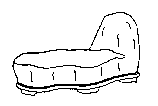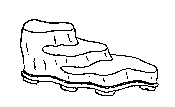What is Suiseki
By Frank English
Suiseki (Sui=water, Seki=stone) is the Japanese name for those serenely attractive "Viewing Stones" frequently shown in conjunction with minature trees at Bonsai exhibits
Not just accent pieces for the Bonsai, Suiseki stones are themselves examples of a classic oriental art form with long established standards for judging and display.
Basically the art of Suiseki involves the collection, preparation and appreciation of certain unaltered naturally formed stones. These stones are found in mountain streams, on wind blown
deserts, along ocean beaches - anywhere the forces of time and nature may have temporarily deposited them. They are chosen from among the countless stones examined for their perceived resemblance
to familiar scenes in nature or to the various objects closely associated with nature.
There are three main category groupings in Suiseki. The first and most popular being Scenic Landscape Stones. These may evoke impressions of distant mountains, islands, waterfalls,
caves, river-formed terraces, lakes and other examples of natural topography.
Object Stones constitute another primary grouping. Included are stones resembling man-made objects such as boats, bridges and old Japanese thatched huts. Also prized are animal-shaped
stones, bird stones, and stones that resemble fish, insects and human figures.
Pattern Stones make up the third category. They are valued for their unique surface patterns resulting from variations in color, unusual texture and contrasting mineral inclusions.
Best known of this group are the beautiful Japanese chrysanthemum stones. Others include tiger-striped stones, celestial (sun/moon/star) patterned stones and abstract pattern stones.
To the Japanese collector the essence of Suiseki is more than just representational. It is also spiritual. Quoting from a pamphlet of the San Francisco Suiseki Kai,"The contemplation of
a stone as a symbol of nature relaxes the mind from pressures of a complex daily life and allows a person to retain his sense of values. The importance of life in its simplest form is
reflected through the beauty, strength and character of the stone."
A fundamental premise of Suiseki requires that the stone be kept in nearly "as found" condition. The only acceptable modification is a leveling cut sometimes made at the bottom of a piece
so that it can fit on a display stand. Much of the appeal of this natural form of art lies inthe viewer's realization that the stone being contemplated could have taken hundreds, thousands
or even millions of years in forming.
Suggested Readings:
"The Japanese Art of Stone Appreciation" by Covello and Yoshimura
"The Art of Suiseki" by Willie Benz
"Suiseki: The Japanese Art of Miniture Landscape Stones" by Felix G. Rivera
A great site to check out: www.suiseki.com
More Tips When Hunting Suiseki Viewing Stones
Look for hard (5-7 on Moh's scale) smoothly weathered stones in darker shades with white inclusions.
Avoid cracked material as well as crystals, fossils & petrified wood formations.
Don't forget to look at oversize rocks from all sides with a baseline "leveling cut" in mind.
A large rubber band stretched over a prospective "keeper" can form a temporary visual baseline.
|
Tips For Suiseki Hunters

Mountain Stones--YAMAGATA ISHI
One or more well-defined peaks--odd in number if more than two. All sides slope down and outward.
Main peak is offset to right or left of center.
Height and depth are 1/4 to 1/2 stone's overall length.
Basic outline is that of an asymmetric triangle - no excessive overhangs.
Distant Mountain, has smooth subtle contours.
Near View Mountain, shows rugged surface detail.
Only flat side, should be the bottom.

Island Stones--SHIMAGATA ISHI
Many features in common with Mountain Stones, though some have lower profiles, steeper sides.
White quartz "breakers" at base are a special plus.
Preferably Island Stones will show some indication of a cove or landing site.

Plateau Stones--DOHA ISHI
A level plain parallel to the base leads to a peak at one end, approximately 1/4 the stone's overall length.
Plateau joins the peak along an open-face diagonal as viewed from the front.
Some Dohas, instead of level plains, feature low-lying foothills rising toward a distant peak.

River-Terrace/Step-Stones--DAN SEKI
Two or more ( more is better) flat parallel levels, including the top as one of these levels.
Levels vary in size and in height of vertical rise.
Top level has approximately 1/4 of the total area covered.

Waterfall Stones--TAKI ISHI
The waterfall is indicated by quartz or other light colored inclusions in a dark background material.
Waterfall originates at or near the top, preferably between two peaks of unequal height.
Width of waterfall increases as it descends.
Waterfall cannot run over and down the back side.
Falls are often featured in other Suiseki styles.

Waterpool Stones --MIZUTAMRI-ISHI
One or more natural depressions suggestive of lakes, ponds or pools.
Ideally the pool is backed by low mountains & includes a noticeable outet area.
A single pool is the dominant feature of its stone.
Multiple pools may be in varying size.
|












